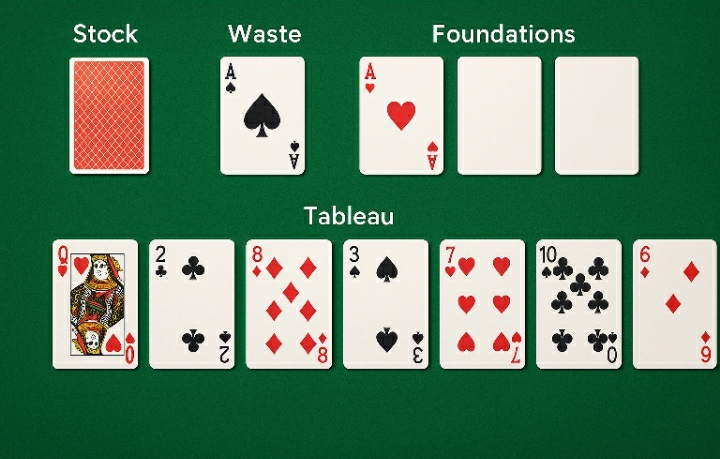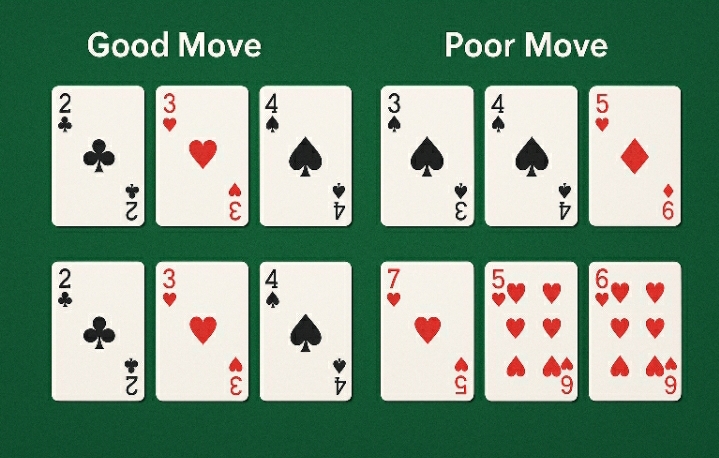Last winter, during a particularly brutal blizzard that knocked out my internet for three days, I rediscovered something magical—a dusty deck of cards tucked away in my kitchen drawer. What started as desperate entertainment became an obsession with A Beginner’s Complete Guide to Playing Solitaire that would transform those boring evenings into strategic challenges.
Solitaire isn’t just a computer game your boss caught you playing in 1995. It’s a centuries-old family of card games that sharpens your mind, reduces stress, and provides endless entertainment without requiring an internet connection or another player. Whether you’re stuck in a waiting room, dealing with insomnia, or simply want to unwind after a long day, mastering solitaire gives you a reliable escape that fits in your pocket.
In this comprehensive guide, you’ll discover the fundamental rules of classic solitaire, learn winning strategies that actually work, explore popular variations, and understand why this timeless game continues to captivate millions of players worldwide.
What Is Solitaire? Understanding the Basics
Solitaire, also known as Patience in British English, encompasses over 500 different single-player card games. The term “solitaire” comes from the French word meaning “solitary,” perfectly capturing the solo nature of these games.
The most recognizable version—Klondike Solitaire—became synonymous with the genre after Microsoft included it in Windows 3.0 in 1990. However, solitaire games have existed since the 18th century, originally serving as fortune-telling tools before evolving into pure entertainment.
Core Components Every Solitaire Player Should Know
The Foundation: These are the four piles where you build your winning sequences, typically from Ace to King in each suit.
The Tableau: The main playing field consisting of seven columns of cards, where most of your strategic moves happen.
The Stock: The remaining deck of cards you haven’t dealt, which becomes your lifeline when moves become scarce.
The Waste Pile: Where you place cards drawn from the stock that can’t immediately be played.

How to Play Classic Klondike Solitaire: Step-by-Step Instructions
Setting Up Your Game
- Deal the Tableau: Create seven columns with 1, 2, 3, 4, 5, 6, and 7 cards respectively. Only the top card in each column should be face-up.
- Position the Stock: Place the remaining 24 cards face-down as your stock pile.
- Create Foundation Spaces: Reserve four spaces above the tableau for your foundation piles.
Basic Gameplay Rules
The Golden Rule: You can only move face-up cards, and they must follow specific placement rules.
Building Down: In the tableau, place cards in descending order while alternating colors (red Queen on black King, black Jack on red Queen).
Building Up: Foundation piles build from Ace to King in the same suit (Ace of Hearts, 2 of Hearts, 3 of Hearts, etc.).
Moving Sequences: You can move entire sequences of properly arranged cards together, but only if you have an appropriate destination.
Winning the Game
Victory comes when all 52 cards rest in the four foundation piles, each containing a complete suit from Ace to King. Sounds simple? The challenge lies in the strategic decisions you make along the way.
Essential Solitaire Strategies That Actually Win Games
After playing hundreds of games, I’ve discovered that successful solitaire isn’t about luck—it’s about recognizing patterns and making smart choices. Here are the strategies that transformed my win rate from 15% to over 60%.
The Reveal Priority Strategy
Always prioritize moves that reveal hidden cards. A face-down card in your tableau is potential energy waiting to be unleashed. When choosing between two equally valid moves, select the one that flips a hidden card.
Focus on the largest columns first. The seven-card column holds the most secrets, followed by the six-card column. These longer sequences often contain the keys to victory.
The Empty Column Advantage
Empty tableau columns are gold. They provide flexibility that can save seemingly impossible games. Only fill empty columns with Kings, as they’re the highest-ranking cards and offer maximum building potential.
Don’t rush to fill empty spaces. Sometimes patience pays off—wait for the right King that opens up more possibilities.
The Stock Management Technique
Think before you draw from the stock. Each card you pull creates a commitment. Before drawing, scan your tableau for possible moves you might have missed.
Track what’s buried. Pay attention to which cards you’ve seen in the waste pile. This information guides your tableau decisions and prevents you from getting stuck.

Popular Solitaire Variations Every Player Should Try
Spider Solitaire: The Ultimate Challenge
Spider Solitaire uses two decks and requires building complete sequences from King to Ace within the tableau itself. It’s significantly more difficult than Klondike but offers deeper strategic gameplay.
Difficulty Levels:
- One Suit: All cards are spades (easiest)
- Two Suits: Spades and hearts (moderate)
- Four Suits: All suits (expert level)
FreeCell: The Thinking Person’s Solitaire
FreeCell deals all cards face-up from the start, making it a game of pure strategy rather than luck. Nearly every FreeCell deal is winnable with perfect play, making it ideal for players who prefer skill over chance.
Pyramid Solitaire: Quick and Addictive
This variation involves removing pairs of cards that add up to 13. It’s faster-paced than traditional solitaire and perfect for short gaming sessions.
| Game Type | Difficulty | Average Game Time | Skill vs. Luck |
|---|---|---|---|
| Klondike | Medium | 10-15 minutes | 70% Skill, 30% Luck |
| Spider | Hard | 15-25 minutes | 80% Skill, 20% Luck |
| FreeCell | Medium-Hard | 8-12 minutes | 95% Skill, 5% Luck |
| Pyramid | Easy | 3-5 minutes | 50% Skill, 50% Luck |
Common Mistakes That Kill Your Winning Chances
The Undo Trap
Modern digital solitaire games offer unlimited undos, creating a dangerous temptation. While occasional undos are acceptable for learning, excessive use prevents you from developing real strategic thinking.
Moving Too Fast
Solitaire rewards contemplation, not speed. Before making any move, scan the entire board for alternatives. The obvious move isn’t always the best move.
Ignoring Suit Distribution
Pay attention to which suits are buried where. If you’ve only seen one red 10 and it’s buried under six cards, factor that information into your foundation-building decisions.
Digital vs. Physical: Choosing Your Solitaire Experience
The Case for Physical Cards
Playing with actual cards engages different cognitive processes. The tactile experience of shuffling, dealing, and moving cards provides a meditative quality that digital versions can’t replicate. Plus, you’ll never worry about battery life or screen glare.
Digital Advantages
Modern solitaire apps offer features impossible with physical cards: automatic scoring, statistics tracking, daily challenges, and the ability to try multiple variations instantly. Popular platforms like Microsoft Solitaire Collection and World of Solitaire provide excellent starting points.
Building Your Solitaire Skills: A Progressive Learning Path
Week 1-2: Master the Basics
Focus exclusively on Klondike Solitaire. Aim for understanding the rules intuitively rather than chasing wins.
Week 3-4: Develop Pattern Recognition
Start noticing recurring situations and optimal responses. Keep a mental note of moves that consistently lead to success or failure.
Month 2: Expand Your Repertoire
Introduce one new variation per week. Each variant teaches different strategic concepts that improve your overall solitaire intelligence.
Month 3 and Beyond: Advanced Techniques
Study probability concepts, card counting methods, and advanced strategic frameworks used by competitive solitaire players.
The Surprising Benefits of Regular Solitaire Play
Research suggests that card games like solitaire provide genuine cognitive benefits. A 2019 study by the University of Rochester found that strategic card games improve working memory and processing speed in adults over 50.
Mental Health Benefits:
- Reduces anxiety through focused concentration
- Provides a healthy escape from daily stressors
- Improves pattern recognition and strategic thinking
- Offers a sense of accomplishment through skill progression
Practical Benefits:
- No equipment needed beyond a deck of cards
- Playable anywhere, anytime
- Scales from 5-minute quick games to hour-long sessions
- Completely free entertainment
Conclusion
Solitaire transforms from a simple card game into a strategic meditation when you approach it with the right mindset and knowledge. The combination of skill, strategy, and just enough luck creates an endlessly engaging experience that has survived centuries for good reason.
Remember, every solitaire master started exactly where you are now—with curiosity and a willingness to learn from both victories and defeats. The strategies and techniques in this guide will accelerate your progress, but the real joy comes from discovering your own preferred playing style and celebrating those satisfying moments when everything falls perfectly into place.
Ready to start your solitaire journey? Grab a deck of cards or download a quality solitaire app and begin practicing these fundamentals. Share your biggest solitaire victories in the comments below, or let us know which variation becomes your new obsession!
Frequently Asked Questions
What is the easiest type of solitaire for beginners?
Klondike Solitaire is ideal for beginners because it balances strategy with simplicity. The rules are straightforward, games finish in 10-15 minutes, and it provides the perfect foundation for learning more complex variations. Most people already have some familiarity with Klondike from computer versions.
How many solitaire games are actually winnable?
In Klondike Solitaire, approximately 79% of deals are theoretically winnable with perfect play, though achieving perfect play requires exceptional skill. FreeCell has an even higher win rate at nearly 99%, while Spider Solitaire varies dramatically based on difficulty level—from 90% for one-suit games to about 50% for four-suit games.
What’s the difference between Solitaire and Patience?
These terms refer to the same family of single-player card games. “Solitaire” is the American term, derived from French, while “Patience” is the traditional British term. The gameplay and rules remain identical regardless of which name you use.
Can playing solitaire actually improve your mental abilities?
Yes, research indicates that regular strategic card game play can enhance working memory, improve problem-solving skills, and maintain cognitive flexibility as you age. The pattern recognition, forward planning, and decision-making required in solitaire provide genuine mental exercise.
How long should I spend learning basic solitaire before trying variations?
Most players benefit from 2-3 weeks of regular Klondike practice before exploring variations. This timeline allows you to internalize basic concepts like building sequences, managing empty columns, and stock pile strategy. However, if you’re feeling confident earlier or getting bored, don’t hesitate to try FreeCell or Pyramid Solitaire for variety.
Why do I keep losing at solitaire even when following strategies?
Solitaire combines skill with chance, meaning even perfect strategy won’t win every game. Focus on improving your decision-making process rather than just win rates. Additionally, some digital solitaire games use predetermined deals with varying difficulty levels, so consistent losses might indicate you’re playing particularly challenging arrangements.
Sources:
- University of Rochester. “Strategic Card Games Improve Cognitive Function in Older Adults.” Journal of Cognitive Enhancement, 2019.
- World of Solitaire. “Solitaire Game Statistics and Winning Percentages.”